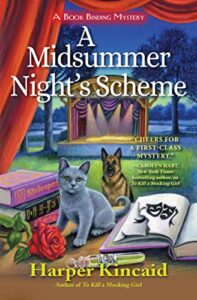If I were a comic book heroine-or villain-the following would be my origin story:
When I was seven years old, my teachers called my mother in for a conference, informing her they didn’t think I was going to cut it at their fine academic institution. It was a small, Hebrew day school, with only twelve kids in my graduating class. Half the day we focused on our secular studies and the other half praying, studying Talmud, and learning how to read and write Hebrew. Think of it as the Jewish equivalent to Catholic school-equal amounts of guilt, but no penguins with corporal punish kinks. I would sit in class and stare off into seeming nothingness: eyes glazed with my mouth hanging slack, because Florida is a swamp I’m still allergic to and I had breathing issues. I would put two dots for eyes on my fingertips and pretend they were people under my desk.
My mother took me in for psychoeducational testing which lasts hours—at least I think it did. I have time blindness, which means without a clock in my face, I have no concept of time. At the end, a lady gave me blank paper and crayons, saying I could color anything I wanted. And I remember thinking, ‘whatever I draw, she’s going to think that’s how I feel about myself.’ So I drew what was expected of me: a little girl smiling under a brilliant sky of blue, surrounded by flowers and endless possibilities. When she came collecting, I saw her eyes scan my creation, the smallest hint of a smile curling the corner of her mouth. I had passed—both the test and my first-time masking as normal.
I didn’t learn the results of that testing until many years later, but I remember something has changed when I returned to school. I went from teachers treating me like the village idiot one day to being the delightful, whip-smart eccentric the next. They diagnosed my auditory processing disorder but missed my ADHD and anxiety disorder. It was the Seventies, is the only excuse I can think of for the lapse.
What I was left with, for the years in between, was a simmering, unnamable rage that ate around the edges of the mask I kept on, trying to appear like everyone else. But I wasn’t normal: I was neurodivergent (ND). And now, after years of therapy and two master’s degrees, I spend my days working as a psychotherapist and my nights writing mysteries starring neurodivergent characters who bring along the quirky while solving murders in their small town.
The term neurodiversity was coined by Australian sociologist Judy Singer, who recognized that people whose brains processed, learned, and behaved in ways different than what was considered ‘typical’ were part of a neurological minority on par with other groups in a socio-cultural context. The term signified a paradigm shift, away from a pathological model of illness to a balance between a healthy social model and a strong medical model, beneficial to society at large. Some conditions that reside under this term are:
Autism Spectrum Disorder (ASD)
The term Asperger’s Syndrome is no longer used, due to its problematic origins.
The levels range from least to most severe in areas of accommodation needs, from Level 1 to Level 3.
Attention Deficit Hyperactivity Disorder (ADHD)
No longer just called ADD.
Dyspraxia, dyslexia, dyscalculia, epilepsy, hyperlexia, obsessive-compulsive disorder (OCD), and Tourette syndrome (TS).
Neurodivergent characters are now mainstream, but learning how to write about them-accurately and compassionately-is still new. So I’ve compiled the following tips to help you write about neurodivergent folks that’s both accurate and page-worthy.
(Warning: Some of the examples may be triggering to people.)
- Hyper Focus Has Its Perks: Research, Research, Research
Whether or not you identify as a member of the neuro-tribe, you’ll be expected to do your homework. That’s a given. But where you go for your information makes a huge difference and will inform the tone of your work.
Here’s an example: you’re writing a novel from the perspective of a young adult with autism. If your sources are the parents, the mental health practitioners, the DSM-V (that’s the American Psychiatric Association’s Diagnostic Statistical Manual, the standard for behavioral health diagnostics), and advocacy organizations representative of the ND, your writing may have an unintended paternalistic, medical model lens that robs your character of their voice, maybe even their sense of agency.
Use the aforementioned sources for your neurotypical adult characters, because they’re part of the narrative landscape, but not for your NDs of any age. Being a former historian, my first go-to will always be primary sources: people with ND. I recommend interviewing as many people as you can, even if you’re an ND author writing characters based on your own experiences. Like any other group, we are not a monolith. Go to support groups (Meetup.com has listings, depending upon where you live), watch documentaries, follow ND content creators on Instagram, TikTok or posts on Reddit and Tumblr. Advocacy groups run by people with ND are also preferable but check with the ND tribe of your focus—some are considered to have outdated missions and ethos, at best, and harmful, ableist ones, at worst.
- Superpower or Disability? It’s Often Both.
Back in the Seventies and Eighties, someone receiving an ND diagnosis was often akin to a social death sentence and being exiled from the life we once knew. There’s no question our society has become more knowledgeable and expansive in our perceptions of neurodiversity. The fact we even use this term demonstrates a strength-based shift in the lexicon.
Within the neurodivergent community, many choose to focus on the advantages of having a different kind of brain. Being able to hyperfocus on topics of interest, creative problem solving, a no-filter communication style that can speak truth to power, and innovative thinking are just some of the ‘superpowers’ we claim.
That said, the neurodivergent brain also has its challenges: difficulty focusing on non-preferred tasks, struggling to pick up on social cues, being uncomfortable with direct eye contact, and problems with executive functioning skills make everyday life not only challenging, but emotional exhausting.
A lesser writer will see this as an either/or dilemma, but the first rule in creating multidimensional, nuanced characters, is to embrace the ‘and’. Being neurodivergent has incredible advantages and potentially crippling disadvantages. Often, the child who had a difficult time reading due to their dyslexia grows up with a strong working memory and highly adept spatial reasoning. Personally, I didn’t learn of my ADHD until I was in my early forties-and it was only after one of my daughters received her diagnosis. From a personal and professional perspective, I can say there were a couple of factors in determining when my brain was more an asset than an albatross:
1. Accommodations
By learning various systems and teaching my daughter how to advocate for herself, I discovered ways in which I could augment my own hard-earned skills I had DYI’d for myself pre-diagnosis. Accommodations are not ‘cheating’ or ‘taking the easy way out’: they are available because there are areas in functioning that are at a deficit. They level the playing field. Characters that have accommodations will be able to access their strengths more easily which affects their self-esteem. Characters who don’t have accommodations will often struggle in many areas of their lives, leading to internalized, ableist notions of being less than. Let these realities inform your writing.
2. Others’ Perceptions
If the people surrounding your protagonist remain stuck on the disability end of the neurodiversity belief spectrum, they may underestimate and infantilize your character, which in turn will affect their self-esteem. Conversely, if they only want to highlight the ‘superpowers’ of your character, constantly downplaying their struggles, your protagonist will be left feeling unseen and isolated. These supporting characters’ attitudes can be used as tools for your character’s story arc, either as fodder for their successes or impediments to their growth.
- Avoid Ableist Traps on Your Heroine’s Journey
Many of us learned how to develop our writing by embracing The Hero’s Journey, the tried-and-true formula that takes readers on a rollercoaster ride of trials and triumphs, leaving our protagonist wiser, stronger than when they started. Neurodivergent characters can have their journey too—if you are mindful of where you’re leading them. Having characters trying to ‘overcome’ their ND assumes they are starting from a place of illness with the goal being ‘cured’. There is no cure. Are there struggles? Absolutely, but I can say once I embraced the unique way my brain interacted with the world, the more I was able to achieve higher functioning and self-efficacy, which were my wins. Make sure to take note of your language as well. Talk to your community. Some prefer the strengths-based descriptor as ‘a person with name-your-ND’ while others insist on the older identifier ‘I’m an ND person’. I am careful not to use phrases like ‘confined to a wheelchair’ or words like ‘lame’, ‘crazy’ or ‘stupid’. Even seemingly innocuous phrases like “I’m so OCD” to describe being neat and orderly or “I’m such a spaz” to explain why you dropped something have hurtful, inherently ableist roots.
- The Line Between Realism and Distraction: When to Include Tics and Stims
Neurodiversity is a large umbrella, and underneath covers the gestures, rituals, and traits endemic to various conditions. It’s a mistake to reduce your character to their diagnosis, to merely a compilation of their physical and behavioral markers. That said, accurate representation is important not only for the authenticity of your story, but for people with ND to see themselves in your work. If one of your characters has Tourette Syndrome (TS), for example, they may live with motor and/or verbal tics such as shoulder shrugging, throat clearing, head bobbing—only 1 in 10 people with TS live with the tic responsible for involuntary swearing known as coprolalia and the community will smell it if you’re just highlighting it for shock value.
In this instance, we can emulate a guideline borrowed from authors who portray characters with distinct regional accents and idioms native to the areas in which they live. A fellow writer and friend of mine specializes in historical fiction, specifically from the Scottish Highlands, and when she first started writing, she made sure her characters’ brogue was authentic to the period her story was set in. Her editor and beta readers commended her adherence to her research and then told her to ‘translate’ about two-thirds of it back to a form of English they could more easily understand. The antiquated brogue distracted from the storytelling.
When writing a character with ND, choose a few traits which aligns with their diagnoses—I use the plural here because over 80% of people have more than one—and weave them through your story without mentioning them every time that character is on the page. The character with both autism and obsessive-compulsive disorder (OCD) will have moments in their story arc where their dual diagnoses feel like a non-issue to them, while other times they’ll be a central focus, because their ASD/OCD is either a catalyst towards or a deterrent away from their goal. Sensitivity and empathy, without infantilizing or being exploitative, is crucial.
- Neurodivergence Rarely Comes to the Party Alone: Remember Comorbidity and Intersectionality
In my psychotherapy practice, at least 50% of the people I serve are neurodivergent and of those individuals, about 75% have another diagnosis cited under the DSM-V guidelines. Neurodivergence is rarely a singular entity-and in my field, we call the occurrence of two or more diagnoses comorbidity or condition cross-over.
As you are conducting your research, you’ll start to notice certain conditions like to come in pairs: Autism and ADHD, dyspraxia and dyslexia are examples. The pairings of ADHD and ASD occur because they affect the central nervous system, where the brain manages its language, movement, focus, memory, organization, time management, and social skills. Oftentimes, if your character was assigned female at birth, they are five times more likely to have been either misdiagnosed or slipped under the radar because certain diagnoses, particularly ASD and ADHD, presents with different symptomology than in people assigned male at birth.
People in the ND tribe always belong to other tribes. Don’t ignore them. Most of my clients with ND identify as part of the LGBTQIA community with a variety of sexual and gender identifiers, especially those part of Gen Z. Older millennials and Gen Xers will often not have received a diagnosis until well into adulthood. And despite the high heritability of ND, due to the stigma attached, historically most baby boomers will deny having ND.
Characters who belong to ethnoreligious and/or racial minorities will have to navigate through their community’s norms, expectations, and obligations in ways unique to them. Socio-economic status, level of education, and political leanings will add further dimensions to how your characters navigate their lives as neurodivergent.
This list is far from exhaustive, offering a slice of what is important for you to explore and consider as a writer. If you’d like more tips about how to write about the neurodivergent, comment below or email me at HarperKincaid26@gmail.com. Make sure to follow me on social media and subscribe to my newsletter at HarperKincaid.com. My new book, A Midsummer Night’s Scheme, is published by Crooked Lane and will be released March 21, 2023.
***


















